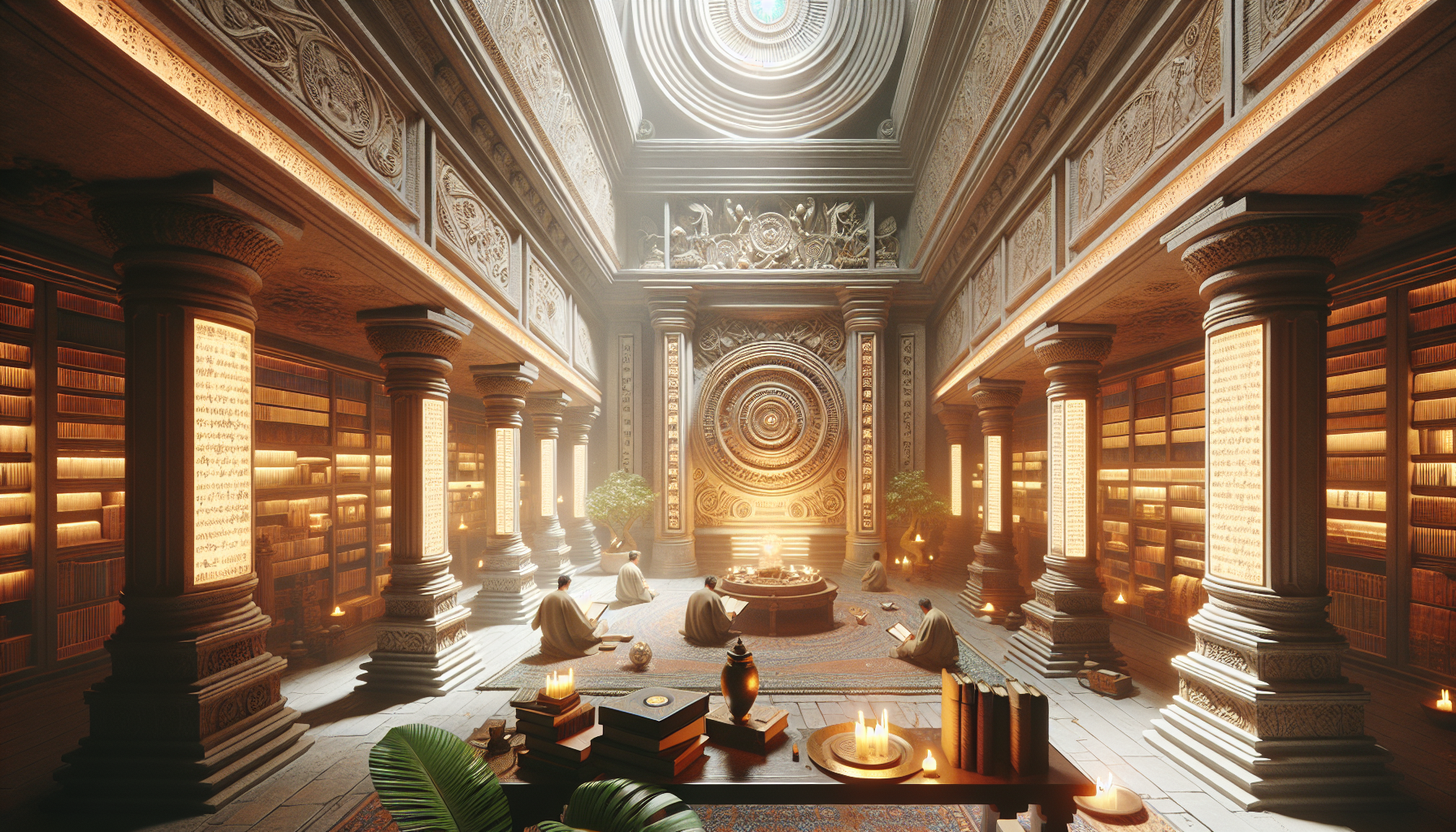In an age where information bombards us from every direction, and attention spans seem to dwindle by the day, the ancient art of memory retention might just hold the key to unlocking a more focused and insightful future. Imagine walking through an ancient temple, each stone echoing with secrets of the past, each corner whispering wisdom long forgotten. This isn’t just a romantic notion; it’s the essence of the memory palace technique—a powerful mnemonic device that has transcended centuries, enabling countless individuals to organize, retain, and recall vast amounts of information. 🏛️
In this blog post, we embark on a journey to explore how these memory palaces—rooted in the hallowed halls of ancient temples—can be revived and harnessed to navigate the complexities of modern life. As we delve deeper, we’ll uncover the historical significance of these architectural wonders and how they were intricately designed not just for religious or cultural gatherings, but as sophisticated tools for learning and remembering. We’ll discuss the interplay between the spatial awareness these structures demand and the cognitive capabilities they enhance, offering a roadmap for applying these techniques in our daily lives.
As we traverse this fascinating landscape, you’ll discover practical applications of memory palaces, drawing from the wisdom of ancient scholars and modern cognitive science. Whether you’re a student aiming to excel in your studies, a professional seeking to optimize your cognitive performance, or simply a curious mind eager to explore new mental vistas, these strategies offer universal benefits. We’ll also examine how memory palaces can be personalized, turning mundane spaces into vibrant, mnemonic-rich environments that reflect your unique thought processes and goals.
By the end of our exploration, you’ll not only appreciate the profound legacy of ancient memory techniques but also feel empowered to integrate these practices into your own life. Together, we’ll unlock the secrets of these timeless temples and discover how their ancient wisdom can illuminate our path forward, enriching our minds and expanding our horizons. Ready to embark on this captivating journey? Let’s step inside and awaken the memory palaces within. 🗝️
The Concept of Memory Palaces
Memory palaces, also known as the method of loci, are ancient mnemonic devices used to enhance memory recall by associating information with specific physical locations. This technique dates back to classical antiquity, prominently used by Greek and Roman orators. The idea is to visualize a familiar space—a palace, house, or even a temple—and populate it with symbolic representations of the information you want to remember. By mentally walking through these spaces, one can easily retrieve the associated information. This method is not only about rote memorization but also involves creating vivid, emotional, and sometimes bizarre imagery to make recall more effective.
In contemporary times, memory palaces have seen a resurgence, especially among competitive memory champions. These individuals use them to memorize decks of cards, long strings of numbers, and extensive lists of words. The secret lies in the spatial navigation abilities of our brains, which are remarkably adept at remembering locations and paths. This capability is deeply rooted in our evolutionary past when recalling locations and routes was vital for survival.
To effectively utilize a memory palace, one should start by selecting a well-known place. For beginners, their home is often the easiest choice. Walk through each room in your mind, noting distinctive features. Assign a piece of information to each feature, and imagine an interaction between the feature and the information. For example, if you’re trying to remember the periodic table, you might place a helium balloon in your living room to represent the element helium. Engage your senses to enhance the memory—imagine the texture, smell, or sound associated with each piece of information.
Historical Context: Temples as Memory Palaces
In the ancient world, temples were not only places of worship but also centers of knowledge and memory. They served as communal memory palaces where sacred texts and knowledge were stored and transmitted across generations. The layout of these temples was meticulously designed to facilitate this function. Each chamber, statue, and artifact had symbolic meanings and were part of a larger narrative structure. This architectural storytelling enabled worshippers and scholars to remember complex theological and philosophical ideas.
In the case of Egyptian temples, hieroglyphs and elaborate frescoes adorned the walls, depicting scenes from mythology and history. These visual elements acted as mnemonic devices, guiding priests and visitors through the spiritual and historical tenets of the culture. Similarly, in India, temples were adorned with intricate carvings and iconography, each telling a part of a larger story, whether it’s the life of a deity or a significant event in the scriptures.
Through these elaborate designs, temples functioned as more than just religious sites. They were repositories of cultural memory, preserving knowledge in an age before printing. These spaces encouraged contemplation and learning, with the architecture itself prompting recollection and understanding. As you explore the ruins of ancient temples today, consider how their spatial and artistic elements might have once served as a complex web of memory triggers.
Reviving Ancient Wisdom: Applying Memory Palaces Today
In our modern world, where digital tools dominate, the ancient art of memory palaces might seem obsolete. However, there’s a growing movement to revive these practices as a means to enhance cognitive skills and preserve cultural heritage. By adapting the memory palace technique to contemporary needs, individuals can improve their memory capacity and cognitive flexibility. This revival is not just about individual memory enhancement; it’s about reconnecting with our cultural past and the wisdom encoded in historical sites.
Institutions and educators are increasingly interested in these techniques to aid in teaching and learning. For instance, educators can encourage students to create mental maps of their curriculum, transforming abstract concepts into tangible experiences. By integrating memory palaces into education, we can make learning more interactive and engaging, moving away from rote memorization to deeper understanding.
Furthermore, the practice of using memory palaces can serve as a meditative exercise, promoting mindfulness and focus. As you visualize walking through your palace, you engage in a form of active meditation, which can reduce stress and enhance concentration. This practice not only improves memory but also contributes to mental well-being.
Comparative Analysis: Modern vs. Ancient Memory Techniques
To understand the evolution of memory techniques, it’s essential to compare ancient practices with modern approaches. The table below outlines some key differences and similarities:
| Aspect | Ancient Techniques | Modern Techniques |
|---|---|---|
| Medium | Physical spaces like temples, with symbolic imagery | Digital tools and apps, virtual reality |
| Methodology | Storytelling, oral tradition, spatial navigation | Data visualization, algorithmic aids, interactive learning |
| Purpose | Preservation of culture, religious rites | Efficiency, accessibility, personal development |
While the mediums and methodologies have evolved, the underlying principle remains the same: leveraging the brain’s spatial and associative abilities to enhance memory. This timeless technique, whether applied through ancient architecture or modern technology, continues to offer profound benefits.
For a deeper dive into how these techniques are applied today, consider watching this informative video: “The Art of Memory: Ancient Techniques for Modern Learning” by Ted-Ed. This video explores how ancient memory techniques are being rediscovered and adapted for contemporary use. 🎥
Practical Steps: Building Your Own Memory Palace
Creating a memory palace is an art that can be mastered with practice. Here are some practical steps to get started:
- Choose Your Palace: Start with a familiar location such as your home, a favorite park, or even an imagined palace. The key is familiarity, as it allows for smoother navigation.
- Plan Your Route: Map out a route through your chosen location, identifying key spots where you can ‘store’ pieces of information.
- Create Vivid Images: For each piece of information, create a vivid, memorable image and place it at a specific location. The more exaggerated and sensory-rich, the better.
- Engage Your Senses: Incorporate sounds, smells, and emotions to strengthen the memory associations. This multisensory approach can significantly enhance recall.
- Practice and Revise: Regularly walk through your memory palace, revisiting each location and image. This repetition helps solidify the connections.
As you become more adept, you can expand your palace, adding more locations and details. The possibilities are endless, limited only by your imagination and creativity.

Conclusion
Certainly! Here’s a conclusion tailored to your article theme:
—
As we arrive at the culmination of our exploration into the captivating world of memory palaces in ancient temples, it’s vital to recapture the essence of the knowledge we’ve uncovered. Throughout this journey, we’ve delved into the profound methodologies our ancestors employed, leveraging architectural marvels and intricate designs to enhance cognitive abilities and preserve vast troves of information. The concept of memory palaces, deeply embedded in historical contexts, served as both practical tools for knowledge retention and as spiritual instruments guiding individuals towards enlightenment.
The marriage between spatial memory and structured visualization in these ancient techniques is nothing short of extraordinary. Our exploration revealed how temples, beyond their religious significance, were meticulously crafted to function as vast mental libraries. These sacred spaces facilitated an immersive experience, enabling individuals to anchor complex ideas and narratives within physical structures. This practice not only fortified memory but also cultivated a deeper connection between the individual, their environment, and the wisdom they sought to preserve.
The significance of reviving these ancient techniques in our contemporary world cannot be overstated. In an age characterized by digital saturation and fleeting attention spans, the principles of memory palaces offer a beacon of hope. They remind us of the untapped potential within our minds and the power of harnessing spatial cognition for personal and intellectual growth. By integrating these age-old practices into modern learning paradigms, we can foster enhanced memory retention, critical thinking, and holistic understanding.
Moreover, the cultural and historical value embedded in these memory systems highlights the importance of preserving ancient wisdom. They serve as a testament to human ingenuity and our eternal quest for knowledge. As we reflect on these insights, we are reminded of the interconnectedness of all human experience, transcending time and geography.
In light of this exploration, I encourage you to reflect on how you might incorporate these timeless techniques into your own life. Whether you’re a student seeking to improve your study habits, a professional aiming to enhance cognitive performance, or simply a curious mind, the principles of memory palaces offer a versatile and accessible tool.
Share your thoughts, experiences, or even personal techniques in the comments below. Engaging in this dialogue not only enriches our understanding but also builds a community of like-minded individuals eager to unlock their mental potential. Feel free to share this article with others who might find inspiration in these ancient practices. Let us collectively celebrate and revive the wisdom of the ages, ensuring it continues to enlighten generations to come. 🌟
For further exploration on this topic, you can visit resources such as the Memory Techniques Wiki or explore detailed studies on ancient mnemonic devices in the Journal of Memory and Language.
Thank you for embarking on this journey with us. May the wisdom of the ancients inspire and empower you to unlock the full potential of your mind.
—
This conclusion aims to encapsulate the essence of the article while encouraging engagement and further exploration of the topic.
Toni Santos is a visual storyteller and cognitive explorer whose work delves into the mental landscapes of ancient cultures—revealing how different civilizations perceived reality, memory, and meaning long before modern psychology existed. Through symbolic imagery and narrative inquiry, Toni brings to life the divergent ways of thinking that shaped lost worlds.
His creative path is guided by a fascination with non-linear logic, oral cosmologies, and the mythic frameworks that once guided decision-making, emotion, and identity. From memory temples carved in stone to visual languages encoded in textiles, every piece Toni creates reflects the vast cognitive diversity of the human story.
With a foundation in visual design and cultural semiotics, Toni blends analytical depth with artistic expression. His work goes beyond historical reconstruction—it reawakens the embodied, intuitive, and ritual-based intelligence of ancient minds, inviting us to question the assumptions of modern thought.
As the mind behind Vizovex, Toni curates visual studies, essays, and immersive content that explore forgotten epistemologies—ways of knowing that connected people to myth, land, and each other in profoundly different ways.
His work is a tribute to:
The symbolic intelligence of pre-modern cultures
The neural diversity embedded in ancient rituals and storytelling
The deep memory systems that shaped identity and perception
Whether you’re a researcher, an artist, or a seeker of hidden wisdom, Toni invites you to enter a space where cognition is culture, and where the past speaks through signs, cycles, and symbols—one myth, one memory, one mind at a time.





